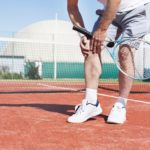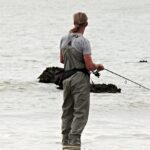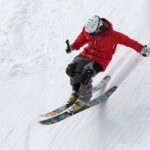Recent Posts
Skiing Vs Snowboarding: Differences
25th July 2023Best Tips For Fishing: Beginners and Intermediate Fishers
25th July 2023Cycling Safety Measures and Best Practices
16th July 2023Benefits Of Cycling For Physical and Mental Health
15th July 2023How To Avoid And Treat Sports Injuries

With food, sport is one of the pillars of a healthy life. However, it can bring a lot of inconveniences, such as injuries. These occur by accident or are the result of bad practice during training. The risk of getting injured also increases when the body is forced to go beyond its capabilities. Identifying the injury and its causes is the first step for a quick recovery and the prevention of other injuries in the future a quick tour of the most common injuries and the actions to prevent them.
SPRAINED ANKLE
This injury usually occurs in football, tennis, or basketball. These are sports called “pivot” because the foot turns a lot on itself and the weight supported by the ankles varies brutally. In most cases, the sprain is caused by the internal twisting of the lateral ligaments of the joint. It can also be caused by bad running or jumping, or by rough terrain. The sprain is characterized by mild inflammation of the ankle, which is accompanied by acute pain and difficulty in setting foot on the ground. Most often, it is a distension of the ligament. In the most severe cases, the ligament breaks.
How to prevent it?
Moderate the intensity of physical exercise during the first sessions, then increase the effort gradually.
Sprain Treatment: Start by applying cold to the affected area. Immobilize the ankle and keep it elevated. The period of recovery depends on the severity of the sprain.
MUSCLE OVERLOAD
Muscular overloads in the thighs and calves are frequent in joggers, although they are also seen in other sports. This type of injury can also occur after the first sessions at the gym, in the extremities (feet and hands) and at the cervical level. Muscle overload is caused by the prolonged repetition of a movement resulting in fatigue of the muscle involved. The first symptoms are heaviness and pain in the affected areas. The leading cause is excess training. But other causes such as weight loss can cause it because of the weakening of the muscle mass.
This is a benign lesion but be careful, if you do not spare when the pain comes, it can turn into tendonitis or muscle contracture.
How to prevent them?
To avoid overloading the muscles, it is advisable to follow a progressive training plan according to your physical abilities. And above all, never skip the warm-up phase. A diet rich in carbohydrates and protein just before training also helps strengthen muscle tissue.
Treatment of muscular overloads: Rest is advised until the muscles of the affected area have recovered. Stretching, massage and warmth help relieve pain. When the pain is gone, it is better to strengthen the muscles to avoid new muscle overload.
FRACTURES OF THE FINGERS OF THE HAND
It is a common injury among basketball players and goalkeepers in football. The most commonly affected areas are the middle (or medial) and proximal phalanges, the metacarpal bones and the distal phalanges (wanting to flatten the balloon). It manifests as a dry sound at the time of the fracture, followed by pain and swelling. The area becomes insensitive.
How to prevent them?
The blows and falls being the cause of these fractures, there is no way to avoid them. For football and basketball players, strengthening the muscles of the hand and specific exercises to warm hands can reduce the risk of fracture.
Treatment of fractures of the fingers of the hand: the treatment varies according to the type of fracture. In most cases, a splint is placed that covers part of the fingers, the hand, and the wrist. If the fractured bone is diverted, the doctor will have to straighten it. The use of surgery is necessary in the most severe cases, including fractures with bone displacement.
CROSS LIGAMENT LESIONS
This injury occurs most often in sports where the legs are subject to sudden changes of pace or direction such as football, hockey, basketball or skiing. The cruciate ligaments – anterior or posterior – and the lateral ones ensure the stability of the knee. The anterior cruciate ligament is the most prone to this type of injury, especially after a sudden movement (such as bad support or a dry stop). The break is characterized by a slam followed by intense pain and difficulty in positioning the leg.
The posterior cruciate ligament breaks less frequently, and the pain is often related to previous road accidents with frontal impact.
How to prevent it?
Exercises to strengthen the pelvic muscles can reduce the risk. Regular practice of jumping exercises can also help improve muscle control in the legs. Finally, the strengthening of the ischial muscles allows a better flexion of the knees during the landing of a jump.
Treatment of the cruciate ligament rupture: it is a severe lesion, and the recovery is long. Some people will never recover their mobility level before the injury. Initial treatment consists of treating inflammation of the area with cold and resting completely. The leg should also be elevated for proper blood circulation. In the most severe cases, surgery is unavoidable. After the operation, the patient must not practice any sport for more than three months.
EPICONDYLITIS AND EPITROCHLEITIS
The epicondylitis or “elbow of the tennis player” mainly affects, as its name suggests, racket sports. It occurs after an intense effort of the extensor tendons of the wrist and fingers. Epitrochlear has affected the flexor tendons lying opposite the elbow. It is common among golf players and motorcyclists.
Both types of injury usually occur in people over 30 years of age and cause acute pain in the joint.
How to prevent them?
Stretching before the practice of sport and frequent change of position with the racket can reduce the risk. Treatment of tennis elbow and golfer’s elbow: Rest is indicated initially until the pain subsides. Pain can be alleviated by applying ice to the area. Be careful; if the wound is not treated, it can become chronic because the tissue does not have time to heal.
LESIONS OF THE ACHILLES TENDON
The Achilles tendon is the essential muscle of the calf. He is also the largest and most potent of the entire human body. It can support up to ten times the weight of the body. This tendon makes it possible to perform plantar flexion of the ankle and to start the impulse of the body forward during walking or running.
Injuries to the Achilles tendon are often linked to the practice of a sport in which running and jumping predominate. It is caused by extreme rotation of the foot inwards or by shock. The tendinitis tendon causes pain in the heel while running or walking and stiffness of the calf. It can range from simple inflammation to tearing in the most severe cases. The latter occurs when the extension of the tendon is too great.
How to prevent them?
This type of injury often affects people who have wanted to perform a strenuous exercise and who require training when they are not physically prepared. They can be avoided by stretching and warming up. The intensity of the workouts must also be modulated. Beginners must go gradually. This is especially recommended for people who arrive at an age when Achilles’ tendons are not as elastic as before. Wearing shoes that promote stable support and proper foot maintenance also reduces the risk of injury in this area.
Treatment of Achilles tendon lesions: the foot must be immobilized in order not to work the tendon and facilitate recovery. To relieve pain and inflammation, apply ice to the injured area. In case of tearing of the muscle, the surgical intervention is necessary.
THE FRACTURE OF THE CLAVICLE
Cyclists are the most affected by the fracture of the clavicle. It can also occur in skiers and people practicing a contact sport. It is caused by a fall. The most vulnerable area is the middle of the bone. The injury is visible through the skin because of the part of the broken bone points under the skin. A hematoma is formed and is accompanied by intense pain, difficulty in moving the arm, and sometimes a tingling sensation in the arm and fingers.
How to prevent it?
Skiers must check their equipment before going on the slopes. Their skis must release the shoes in case of fall. To prevent the injury from being too serious in case of a fall, it is vital to take care of your bones through the diet (rich in calcium and vitamin D because it fixes calcium) and the regular practice of a sport to maintain the strength of the bones.
Treatment of the fracture of the clavicle: it depends on the type of fracture. If the bones are still aligned, immobilization with a bandage is enough. If they are not, surgery is necessary and consists of fixing the clavicle through the establishment of a plate with screws. Convalescence depends on the severity of the injury and the age of the patient. In a child, three to six weeks are enough. In adults, this can last up to three months.
Recent Posts
Techniques and Best Practices for Anglers
21st November 2023Hiking Vs Trekking: Differences and Similarities
12th August 2023How to Lose Weight by Cycling
12th August 2023How to Choose Skis for Beginners
12th August 2023Related Articles
Types of Hiking Trails: Options to Explore
Hiking captures the hearts of people across ages and fitness levels as...
By Fortunatus Adunola25th July 2023Benefits Of Cycling For Physical and Mental Health
Cycling, a broadly embraced hobby, brings forth manifold blessings for each physical...
By Fortunatus Adunola15th July 20235 proven strategies to teach your child skiing.
It’s done, your holidays in the mountains are reserved! To you, the...
By O. Johnson Taiwo11th June 2019Five Activities To Do With Children
Going skiing with kids can often be stressful for parents. But do...
By O. Johnson Taiwo11th June 2019














